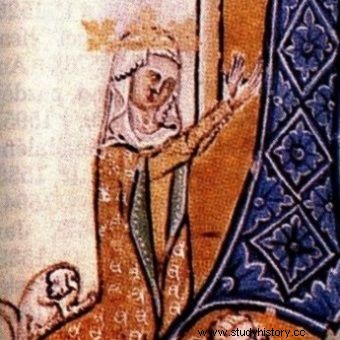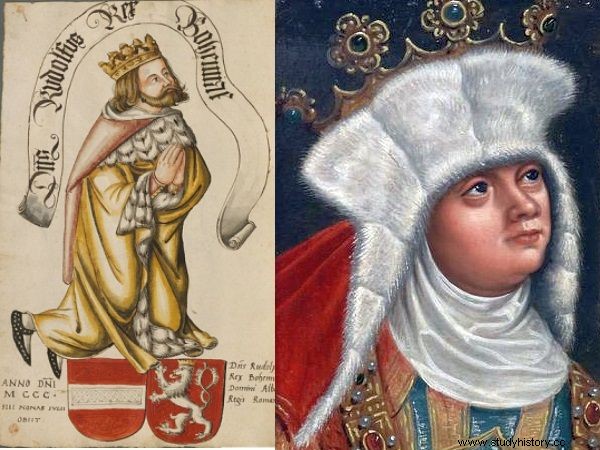The daughter of the Polish king, Przemysł II, Ryks, was a woman famous for her beauty. Beauty did not bring her happiness in love, however. By some strange coincidence her men were dying over and over again ... leaving her with hefty sums and royal titles. Coincidence?
Princess Ryksa was born in Poznań on September 1, 1288. She did not have a peaceful childhood. Probably at the age of only three, she was engaged to the son of Albrecht III Brandenburg, Otto. The fiancé was also her future stepmother's brother , Margaret of Brandenburg. As if that were not enough, Ryksa quickly became an orphan. 
Her mother, under unknown circumstances, died shortly after giving birth. When the girl was eight, her father also passed away. He died in a bloody attack in which she almost certainly dipped her fingers ... his next wife and stepmother Ryksy - Margaret. Such experiences from his youth had an impact on the character of little Piastówna.
A dissolute king and twelve-year-old wife material
The stepmother, without waiting for anything, took the girl to Brandenburg. Preparations began immediately here to marry Otto, but the plans quickly went to the head. The fiancé died around 1297-1299. A dead body was thick in Ryksa's life.

Handing over the fiancée into the care of Gryfina, the widow of Leszek the Black, was not the best idea, considering what she could have knocked into the young princess's head. Gryfina was not an example of a submissive wife, and she and her husband sincerely hated each other, not failing to show it in public. (the picture shows their marriage quarrel).
The Czech king, Wenceslaus II, became seriously interested in the princess, who was again listed on the matrimonial stock exchange. Ryksa had a unique advantage. Her father, as the first prince in decades, proclaimed himself the king of a divided Poland. Even if he gave up his ghost shortly after, his act was still important.
In July 1300, he brought her to Prague and entrusted her to the care of his aunt, Gryfina, the widow of Leszek the Black. At that time, there were also engagements, but the formal wedding was still far away due to the young age of the princess. Wacław, 29, who led a very dissolute lifestyle, was in no hurry to get married . As one of his contemporary Czech historians put it delicately:
the king wasted physical strength before he was mature .
On the other hand, Dante, who lived more or less at the same time, placed Wenceslas in purgatory while writing "Divine Comedy":
Ottokar was better in a nappy than Wacław, his bearded son, who fed the soul with debauchery and luxury.
The king kept many misfortunes, and marrying the 12-year-old Polish woman was purely political. And although from the point of view of Polish law he did not "inherit" the kingdom, nor could he make any claims to the Polish crown, as the Czech chronicler Dalimil writes:
Wacław took a Polish princess as his wife, and she had soil in her wreath .
It was a view widely shared among Czech historiographers - together with Ryksa, Wacław received the Polish crown "in a package".
Not bad, no bad habits, wealthy…
It is difficult to say whether Ryksa was pleased to be married to a Czech king. Certainly, from a practical point of view, a more dignified marriage could not have happened to her.

Wenceslaus II, entering Prague in 1282, after he married Ryksa, did not live long.
The future husband did not conduct himself well and the young princess could not expect him to settle down for her sake, but he was still quite an attractive man.
Wenceslaus was probably of medium height, slim, almost flimsy. He had a narrow, long face with large eyes and a narrow, high nose. His face, like that of Přemysl Otakar II, had delicate, almost feminine features. Maybe he had, like his father or daughter Eliszka Przemyślidówna - as the sources say - dark hair and a swarthy complexion (quoted after:Małgorzata Duczmal, "Ryksa Piastówna, Queen of Bohemia and Poland" ...).
Swarthy skin, dark eyes and hair were the features that characterized the Přemyslid people, while Wenceslaus owed his slight build to malnutrition and sickness from his childhood. He did not grow up to be a dribbler, and neither did his father, who was no more than 168 cm, which was the average height for a man at the time.
All in all, Ryks had a pretty good husband. Not ugly, still young, intelligent, with quite an interesting personality, no addictions. Historians, also in the latest studies, give him very good marks - he was a good ruler, he also cared for the economic and cultural development of the kingdom.
Not only Czech and German, but also Polish historians are favorable to Wenceslas. She did not become the wife of the Czech king Ryks until May 26, 1303, taking the name of Elizabeth on his request. The bishop of Wrocław, Henryk of Wierzbno, acting as a delegate of the archbishops of Gniezno and Mainz, crowned Ryks as the queen of Bohemia and Poland, doing so without the consent of the Holy See .
This was later remembered by Pope Boniface VIII to Wenceslaus. The life lasted only two years. Wacław died on June 21, 1305, leaving a 16-year-old wife with a week-old daughter, Agnieszka, at her breast and 20,000 fines of silver binding by a widow. It was then a lot of money that Ryksa was to draw for life from the income of the towns of Hradec, Mýto, Chrudim, Polička and Jaroměř.
Another man in her life has died. She became a very young, rich widow. But she wasn't going to end her career there.
Eight months of marital happiness and two decades of romance
On October 16, 1306, Ryksa remarried 25-year-old Rudolf Habsburg, the eldest son of the German king Albrecht I. As we read in Ottokar of Styria, although he could choose among many virgins, Rudolf:
fell in passionate love with the beautiful 17-year-old widow Queen Rykx.

Rudolf and Ryksa could have become quite a successful couple if it were not for the princess's bad luck. The newly wedded husband said goodbye fairly quickly.
Anonymous from Leoben wrote that Rudolf:
he burned unusually for his love mate, they indulged in excessive hugs all the time .
The wedding at the Austrian court was rich and splendid. It is a pity that this did not guarantee the young people's marital happiness. Rudolf died after less than a year, and Ryksa again received 20,000 silver widow's silver. Evidently, doom was hanging over the young queen and her subsequent relationships.
A way to curse?
Widowed Elżbieta Ryksa was a wealthy and powerful woman. Around 1310 she entered into an affair with the richest and most influential man in the country - Henry of Lipa.

The widowed Ryksa decided that she would never marry again. Was she trying to break her curse this way?
She did it probably in order to win over the new King John of Luxembourg. The ruler of Bohemia was married to Elizabeth, daughter of Wenceslaus II, who was in constant conflict with his former stepmother. The king later bought her properties from Ryksa, but she herself moved to Old Brno in Moravia. Soon her lover joined her, taking over the Starosty of Moravia.
Ryksa did not foresee that a romance calculated to multiply political capital would turn into a real feeling. When Henry of Lipa died in 1329 , Ryksa experienced it deeply, crying and lamenting for a long time. Despite her great affection, the Queen never decided to legalize her long-term relationship with her beloved, and historians still argue about the reasons.
Some argue that if she had married Henry, it would have resulted in the loss of her royal title. She would be demoted by such a decision, she would lose her position and authority. Others, in turn, point to a much more prosaic reason - after all, the loved one was married .
Besides, by getting married, she would lose the independence she had enjoyed in recent years, the right to self-determination, the ability to decide about herself. Probably it would be difficult for her to give up.
There is also a third explanation. Perhaps Ryksa was simply afraid that another attempt to swear an oath would bring bad luck to her relationship, which had haunted her all her life?
